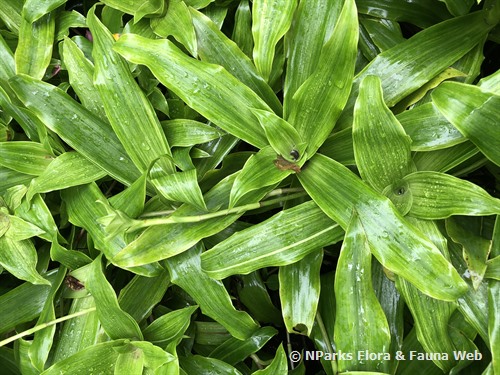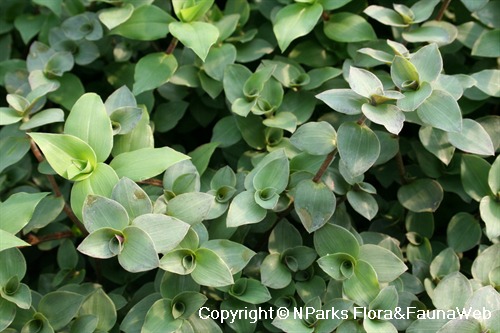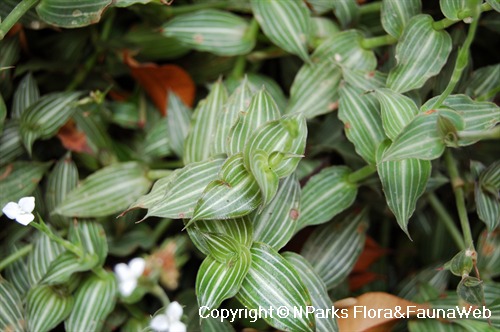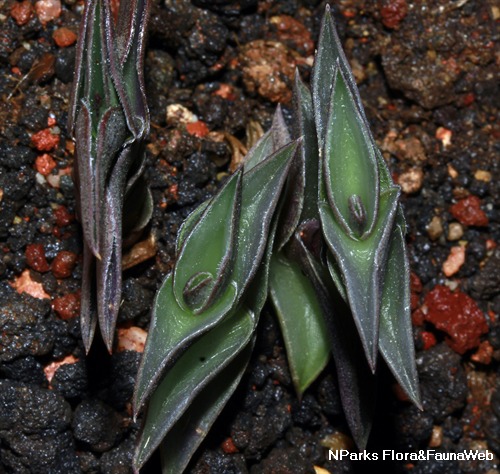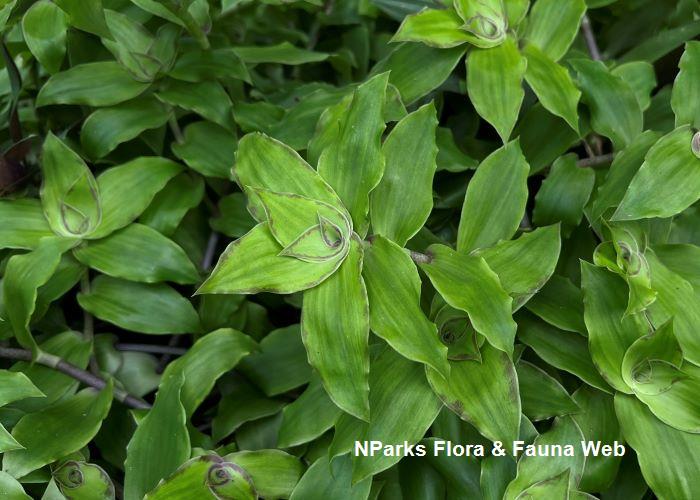
Back
Callisia soconuscensis Matuda
| Family Name: | Commelinaceae |
| Synonyms: | Callisia guerrerensis Matuda |
Callisia soconuscensis is a low-trailing plant that makes a suitable candidate for hanging baskets and elevated planter beds. The egg-shaped leaves are arranged tightly at the tip of the stems, giving it a rosette-like appearance. The plant roots easily at every node and can be easily propagated by cuttings
Name
Classifications and Characteristics
| Plant Division | Angiosperms (Flowering Seed Plants) (Monocotyledon) |
|---|---|
| Plant Growth Form | Herbaceous Plant, Creeper |
| Lifespan (in Singapore) | Perennial |
| Mode of Nutrition | Autotrophic |
Biogeography
| Native Distribution | Guatemala, Mexico Southeast, Mexico Southwest |
|---|---|
| Native Habitat | Terrestrial (Grassland / Savannah/ Scrubland) |
| Preferred Climate Zone | Tropical, Sub-Tropical / Monsoonal |
| Local Conservation Status | Non-native (Horticultural / Cultivated Only) |
Description and Ethnobotany
| Growth Form | It is a low-growing herbaceous trailing plant that occasionally grows erect. Plant may grow over one another, forming a thick mat. |
|---|---|
| Roots | Roots are fibrous, often growing at nodes as it trails. |
| Foliage | Leaves are green, ovate and measure up to 8 cm long and 3 cm wide, acute at the tip and rounded at the base. Leaves grow in tight clusters terminally, arranged in an alternate leaf arrangement. Purple colouration may occasionally be seen around the margin under full sun. |
| Stems | Stems are round and fleshy. Older stems have longer internodes, and are light-purple in colour. |
| Flowers | Flowers are white, composed of 3 ovate petals arranged in a triangle. Flowers are located on clusters, subtended by bracts, arranged on a long inflorescence that grows terminally. |
| Fruit | Fruit is a capsule. |
| Habitat | On the edge of evergreen forests and humid hillside, up to 200 m above sea level. |
| Cultivation | It grows best in fertile, well-draining soil and full, direct sunlight. Under semi-shaded or shade conditions, the plant may grow erect or even 'climb' up vertical surfaces. Watering should be moderate, as the plant may rot if it gets too wet. Occasional pruning is needed as stems will eventually grow bare.It can be propagated through cuttings. |
| Etymology | The genus epithet Callisia is derived from the Greek word kallos, meaning "beauty". |
Landscaping Features
| Desirable Plant Features | Ornamental Foliage, Ornamental Form |
|---|---|
| Landscape Uses | Container Planting, Groundcover, Skyrise / Balcony, Suitable for Hanging Baskets |
| Thematic Landscaping | Naturalistic Garden |
Plant Care and Propagation
| Light Preference | Full Sun, Semi-Shade |
|---|---|
| Water Preference | Moderate Water |
| Plant Growth Rate | Fast |
| Rootzone Tolerance | Easy to Grow, Fertile Loamy Soils, Shallow Media, Well-Drained Soils |
| Pest(s) | Associated with, Chewing Insects |
| Propagation Method | Stem Cutting (Herbaceous, Tip) |
Foliar
| Foliage Retention | Evergreen |
|---|---|
| Mature Foliage Colour(s) | Green, Purple |
| Mature Foliage Texture(s) | Smooth |
| Foliar Type | Simple / Unifoliate |
| Foliar Arrangement Along Stem | Alternate |
| Foliar Attachment to Stem | Sessile |
| Foliar Shape(s) | Non-Palm Foliage (Ovate) |
| Foliar Venation | Parallel |
| Foliar Apex - Tip | Acute |
| Foliar Base | Rounded / Obtuse |
| Typical Foliar Area | Mesophyll ( 45cm2 - 182.25 cm2 ) |
| Leaf Area Index (LAI) for Green Plot Ratio | 3.5 (Shrub & Groundcover - Monocot) |
Non - Foliar and Storage
| Root Type | Underground (Fibrous Root) |
|---|
Floral (Angiosperm)
| Flower & Plant Sexuality | Bisexual Flowers |
| Flower Colour(s) | White |
|---|---|
| Flower Texture(s) | Thin |
| Flower Grouping | Cluster / Inflorescence |
| Flower Location | Terminal |
| Flower Symmetry | Radial |
Fruit, Seed and Spore
| Mature Fruit Colour(s) | Brown, Black |
|---|---|
| Fruit Classification | Simple Fruit |
| Fruit Type | Dehiscent Dry Fruit , Capsule |
References
| References | Matuda, E. (1954) Commelinaceas nuevas de mexico y belice. Boletín de la Sociedad Botánica de México 17: 2-4 |
|---|
Image Repository
Others
| Master ID | 34472 |
|---|---|
| Species ID | 8885 |
| Flora Disclaimer | The information in this website has been compiled from reliable sources, such as reference works on medicinal plants. It is not a substitute for medical advice or treatment and NParks does not purport to provide any medical advice. Readers should always consult his/her physician before using or consuming a plant for medicinal purposes. |



